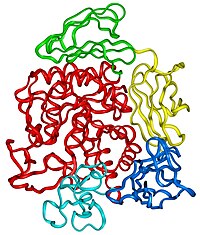Cyclomaltodextrin glucanotransferase
This article includes a list of general references, but it lacks sufficient corresponding inline citations. (March 2020) |
In enzymology, a cyclomaltodextrin glucanotransferase (also cyclodextrin glycosyl transferase or CGTase for short) (EC 2.4.1.19) is an enzyme that catalyzes the chemical reaction of cyclizing part of a 1,4-alpha-D-glucan molecule through the formation of a 1,4-alpha-D-glucosidic bond. They are bacterial enzymes belonging to the same family of the α-amylase specifically known as glycosyl-hydrolase family 13. This peculiar enzyme is capable of catalyzing more than one reaction with the most important being the synthesis of non-reducing cyclic dextrins known as cyclodextrins starting from starch, amylose, and other polysaccharides.
| cyclomaltodextrin glucanotransferase | |||||||||
|---|---|---|---|---|---|---|---|---|---|
 CGTase ribbon diagram | |||||||||
| Identifiers | |||||||||
| EC no. | 2.4.1.19 | ||||||||
| CAS no. | 9030-09-5 | ||||||||
| Databases | |||||||||
| IntEnz | IntEnz view | ||||||||
| BRENDA | BRENDA entry | ||||||||
| ExPASy | NiceZyme view | ||||||||
| KEGG | KEGG entry | ||||||||
| MetaCyc | metabolic pathway | ||||||||
| PRIAM | profile | ||||||||
| PDB structures | RCSB PDB PDBe PDBsum | ||||||||
| Gene Ontology | AmiGO / QuickGO | ||||||||
| |||||||||
CGTase is an enzyme common to many bacterial species, in particular of the Bacillus genus (e.g. B. circulans, B. macerans and B. stearothermophilus) and Brevibacillus brevis.
This enzyme belongs to the family of glycosyltransferases, specifically the hexosyltransferases. The systematic name of this enzyme class is 1,4-alpha-D-glucan 4-alpha-D-(1,4-alpha-D-glucano)-transferase (cyclizing). Other names in common use include Bacillus macerans amylase, cyclodextrin glucanotransferase, alpha-cyclodextrin glucanotransferase, alpha-cyclodextrin glycosyltransferase, beta-cyclodextrin glucanotransferase, beta-cyclodextrin glycosyltransferase, gamma-cyclodextrin glycosyltransferase, cyclodextrin glycosyltransferase, cyclomaltodextrin glucotransferase, cyclomaltodextrin glycosyltransferase, konchizaimu, alpha-1,4-glucan 4-glycosyltransferase, cyclizing, BMA, CGTase, and neutral-cyclodextrin glycosyltransferase.
Catalytic activities
editAll of the CGTases can catalyze up to four reactions: cyclization, coupling, disproportionation and hydrolysis. All these activities share the same catalytic mechanism which is common to all glycosyl-hydrolases.
Cyclization is the process through which a linear polysaccharidic chain is cleaved and the two ends of the cleaved fragment are joined to produce a circular dextrin (cyclodextrin or CD): on the basis of the number of sugar residues this circular product is made of three main type of cyclodextrins can be distinguished, α-CD with six residues, β-CD with seven residues and γ-CD with eight residues.
The coupling reaction can be easily described as the reverse process of cyclization: the enzyme cleaves a cyclodextrin to produce a linear dextrin which is subsequently joined to a linear oligosaccharide.
Disproportionation is very similar to coupling, but the cleaved dextrin is not a cyclodextrin, but a linear oligosaccharide that is then joined to a second oligosaccharide.
CGTase also has a weak hydrolyzing activity which consists in cleaving the longer polysaccharidic chains into shorter fragments.
Structural studies
editAs of late 2007, 47 structures have been solved for this class of enzymes, with PDB accession codes 1A47, 1CDG, 1CGT, 1CGU, 1CGV, 1CGW, 1CGX, 1CGY, 1CIU, 1CXE, 1CXF, 1CXH, 1CXI, 1CXK, 1CXL, 1CYG, 1D3C, 1D7F, 1DED, 1DTU, 1EO5, 1EO7, 1I75, 1KCK, 1KCL, 1OT1, 1OT2, 1PAM, 1PEZ, 1PJ9, 1TCM, 1UKQ, 1UKS, 1UKT, 1V3J, 1V3K, 1V3L, 1V3M, 2CXG, 2DIJ, 3CGT, 4CGT, 5CGT, 6CGT, 7CGT, 8CGT, and 9CGT.
References
edit- DePinto JA, Campbell LL (1968). "Purification and properties of the amylase of Bacillus macerans". Biochemistry. 7 (1): 114–20. doi:10.1021/bi00841a015. PMID 5758537.
- French D, Levine ML, Norberg E, Nordin P, Pazur JH, Wild GM (1954). "Studies on the Schardinger dextrins. VII. Co-substrate specificity in coupling reactions of Macerans amylase". J. Am. Chem. Soc. 76 (9): 2387–2390. doi:10.1021/ja01638a027.
- Hehre EJ (1951). "Enzymic Synthesis of Polysaccharides: A Biological type of Polymerization". Advances in Enzymology and Related Areas of Molecular Biology. Advances in Enzymology - and Related Areas of Molecular Biology. Vol. 11. pp. 297–337. doi:10.1002/9780470122563.ch6. ISBN 9780470122563. PMID 24540594.
{{cite book}}:|journal=ignored (help) - SCHWIMMER S (1953). "Evidence for the purity of Schardinger dextrinogenase". Arch. Biochem. Biophys. 43 (1): 108–17. doi:10.1016/0003-9861(53)90089-7. PMID 13031665.
- Biwer A, Antranikian G, Heinzle E (September 2002). "Enzymatic production of cyclodextrins". Applied Microbiology and Biotechnology. 59 (6): 609–17. doi:10.1007/s00253-002-1057-x. PMID 12226716.
- van der Veen BA, Uitdehaag JC, Penninga D, van Alebeek GJ, Smith LM, Dijkstra BW, Dijkhuizen L (March 2000). "Rational design of cyclodextrin glycosyltransferase from Bacillus circulans strain 251 to increase alpha-cyclodextrin production". Journal of Molecular Biology. 296 (4): 1027–38. doi:10.1006/jmbi.2000.3528. PMID 10686101.